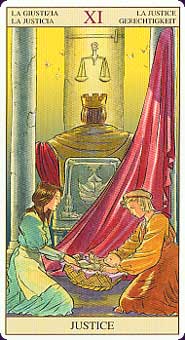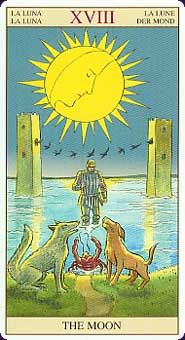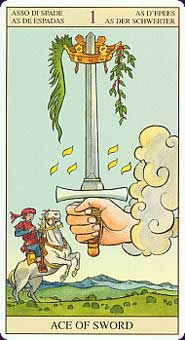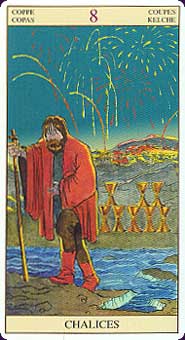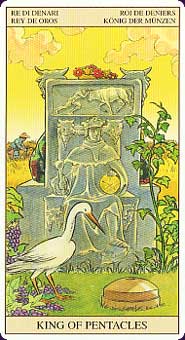Tarot of the New Vision Deck Review
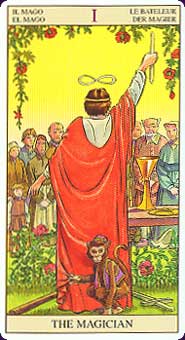
Ever wondered what the Magician was looking at? The Tarot of the New Vision is based on the Rider-Waite, but with a fascinating 180 degree change of perspective which reveals new scenes, people and shades of meaning in the familiar images.
Deck Type: Tarot Deck Cards: 78
Creators: Gianluca Cestaro, Pietro Alligo
Publisher: Lo Scarabeo 2003
Retailers
See Price at Amazon.comSee Price at Amazon.co.uk
Tarot of the New Vision Review by Kate Hill
Have you ever wondered what the Magician was looking at? What was behind the High Priestess? What the Kings and Queens were contemplating? Most tarot enthusiasts are familiar with Pamela Colman-Smith's drawings used for the Rider-Waite deck, and this tarot turns the original drawings around 180 degrees and looks at them from a completely new perspective.
I have been waiting to see these cards since I first heard of "the deck no one thought of" several months ago. My first impression was how much more populated the cards now appeared. More people, new objects, and different landscapes are revealed. Many cards that originally showed only a single figure, now showed them with a spectators, acolytes, children, or animals. There were also more angelic and demonic elements - extra demons or gargoyles appear in the Devil and the Nine of Swords, an angel appears in the Eight of Wands, a winged horse in the Four of Cups, a ghost or spirit in the Seven of Pentacles.
Some cards are not exact 180-degree reversals, and, understandably, some artistic license has been taken so that each image works. Seated figures, like the court cards and Justice, have been treated by showing a frontal view of the card in bas-relief, to look like decoration on the back of the throne.
The art style is detailed; fairly realistic looking pen and ink drawings filled in with watercolour. The colouring has been kept reasonably similar to the original Rider-Waite drawings, but is softer and not as garishly primary coloured. (Interestingly, the two artists for this deck were twin brothers, Raul and Gianluca Cestaro.)
The change of perspective in the card artwork does often also change the perspective of the meaning. While such classic archetypes as Death, the Wheel, the Tower, the Sun, the World don't appreciably change, others are definitely altered. For example, we see the Magician is standing behind his table and performing for a crowd; which tilts the meaning closer to the historical Bateleur than the solitary magical adept of the original Rider-Waite. The Hanged Man faces a jeering mob and has a less spiritual focus and a booklet meaning of 'repentance, points of view, final difficulty'. The Chariot's meaning is also very changed by the reversal of perspective - behind the cart we see a man and a women chained and forced to follow.
In the minors, the card that struck me as the most changed was the 8 of Cups. Previously a person dressed and setting off for a journey, we know see what they were leaving - and it doesn't appear to be a willing departure. The sky is brightly lit with fireworks and the city is in apparent celebrations. The Eight of Wands is also markedly different; usually a simple card of eight wands in the air, this now a view of the wands pointing upward from a farming village, as though departing, and a winged angel. Another interesting turnaround is the Five of Pentacles. This card still shows two figures, lame, poor and weak, but now they are on the inside of the building and light is shining through the stained glass window from the outside.
While beginners could use the Tarot of the New Vision, I recommend this deck for intermediate and experienced readers and students seeking a novel take on the familiar Rider-Waite images.
Tarot of the New Vision Review by Djenra
The buzz about the Tarot of the New Vision (TNV) says that it shifts one's view a full 180 degrees to the back of the card, but in some of the cards that originally faced to the right or left, it feels as if a hard U-turn is made rather than an about face.
The first observation I noted in my read through was that this deck added some totems to the Major Arcana. The Dog of the Fool is a given, but here we see the Owl of the High Priestess, the Monkey of the Magician, the Swan of the Empress, the Turtle of the Emperor and a rock engraved Lamb behind the throne of the Hierophant. The trend is broken after the Lovers who are shown overlooking the Garden of Eden filled with many species of wild life.
In all of the Court Cards and certain of the Majors such as the Emperor, Justice and the Hierophant we find that the back of their thrones are made of a grey stone that is engraved much like a tombstone or a memorial plaque. The height the width of the stone varies in each card. This act links those cards in my mind to the Great and legendary Ancestors. It shows the aspects, virtues and traits of one's elemental, biological, planetary, or spiritual lineage depending of course on ones point of view (POV).
Each deck created today has its particular way to tell the Story of Life. How it does so is communicated via the first layout which reveals the purpose its Creator intended it into being with in conjunction or relationship between the Tarotist's energies. The summary card of the first layout is the answer to the query made to the deck, "What is your purpose in the world?" and it is also a signature and a formula. It is recorded, as it is the way in which the individual asking will interact and interface with the deck in "their" world. In the Tarot of the New Vision (TNV) that opening card for was: the 2 of cups.
This card says that in order for me to appreciate the TNV, I must understand that it is intimately connected to and in a special relationship with the Rider Waite Smith (RWS) deck. Intimacy is a facet of the 2 of cups revealed in this deck. The TNV functions like one who stands behind their lover in a scene. Generally, it is said that one shows one's back only to those you trust not to put a knife in it. The position of observer in this deck adds another dimension, a different POV from another locus. The RWS deck has entered into the Western cultural mind in this century, yet many of its symbols are still overlooked by the glazed stare of the conscious mind. TNV functions as a partner or a lover in regards to the RWS deck. Both Beauty and Truth are virtues found in the eyes of the beholder
Let's take a few examples of this new Tarot starting with the Moon image, which is cited in another review of the deck. What does an armored man exiting the water at night, knife in hand have to do with the Moon? Well, the Moon governs instincts, habitual responses and the autonomic nervous systems of the body. Anger is one of many reactions that are hardwired into the psyche by continued usage. It like other emotions is summoned and erupts from the unconscious instantaneously overriding what is called variously forethought, conscience or common sense. Thus we see the knight emerges from the waters because he has been called.
The metallic shield that he wears is what all anger and negative emotions hide - the sore spots, bruises, and painful experiences held inside the personal unconscious or subconscious mind. We all wear shields, the psychic armor of our human electrical field (HEF) also called the aura, which is invisible to the eyes of most humans. Our societies create laws and provide a justice system of checks and balances (i.e. punishments) as a dam to hold back the tide of impulse, so that anger and violence do overtake and destroy civilization. These ideas are the principles illustrated in the myths of submerging and re-emerging of which Atlantis is the most well known example.
The Queen of Swords is one of the Court Cards that has been spun completely about face but still appears at a 90 degree angle. Tarot lore says that the Queen of Swords is a widow and speaks of her fierceness as a female warrior who takes lives and heads. In some cultures her sword is the blade that cuts the umbilical cord as Mid-wife and as Female Elder or Crone she knows the words that call Death and to sever the silver cord when a transition becomes too painful and difficult for the soul inside a body to bear. In this context the pallbearers and the casket they carry into the distance at the lower right of the cardface fit right in.
The Tarot of the New Vision (TNV) speaks via it's images and brings with it a different POV, which is worthy of considerate evaluation as an alter-ego and as an equal partner with the RWS deck. I find it hard to even classify this deck as a clone. Within the TNV, my opening card held. The reciprocal energies of the 2 of cups was found to be the most appropriate card to express my understanding of this deck. I can honestly state that the use of this deck in the trial period has deepened my understanding of quite a few of the more nebulous cards. This deck has good bones!
Favorite Minor cards in the deck: 2 of Wands, 6 of Disks.
Favorite Major: The Hanged Man.
Least Favorite Majors: The Devil and The Stars.
Tarot of the New Vision Review by Bonnie Cehovet
Tarot of the New Vision is intended to act as a compliment to the Rider-Waite-Smith Tarot deck. In essence, the cards of the Rider-Waite-Smith deck have been turned 180 degrees, so that we can see what lies in front of them (or behind them, as the case may be). Some license has been taken in viewing the figures that are seated sideways in the pictures, and in some instances the veils have been pulled back half-way so that there we get a fuller view of the scene.
Some new symbols were added, and some license was taken in dealing with pictures that included thrones (for the Court Cards and for figures in the Major Arcana). In many cases what would have been shown from the front is shown as being engraved in the back of the throne. The style of art is pen and ink, with the coloring being somewhat pastel and subdued. The illustrators for this deck, Raul and Gianluca Cestaro, are brothers. I find this interesting, because it would seem that what one brother did not see in a card, the other brother would. I think the pairing of the deck and the illustrators did not happen by chance.
The cards themselves are approximately 2 5/8" by 4 3/4", on quality cardstock. They can be handled well, if not easily, by smaller hands, and are sturdy enough to stand up under extensive use. The backs show a 1/4" white border, followed by a 1/2" Celtic knot type border in blue and white. The image in the middle of the card is of the Ace of Pentacles - a hand coming out of a cloud, cupping a disk with a pentagram on it. Under the hand is a small scene of rolling hills, with mountains in the background. On top of the mountain, to the left hand side of the card, sits a castle. There are two sets of images, so that you cannot tell when the card is drawn whether it is upright or reversed.
The face of the card shows a 1/4" white border, with a thin black border around the graphic itself. At the top of the card, in the middle, is the card number. On the bottom of the card is the card title, in English. In the upper left hand corner is the card title in Spanish and Italian, in the upper right hand corner is the title in French and German.
The LWB (Little White Book) that accompanies this deck is indeed a little white book - very small, with very small print. Even so, it manages to carry translations of the material presented for all five languages. Quite the feat there! The meanings of the cards are presented with the use of one or two keywords - there is no discussion of the cards, or the suits, elemental qualities etc.
Two systems of doing readings/divinations are included. The first method is called The Cards of Meditation. It is essentially a card-a-day draw, with journaling of the days events at the end of the day. For those that are easily influenced, it is suggested that the card drawn in the morning not be turned over until the evening, and then compared with the days events.
The second method is called The External Cards and the Internal Cards. The deck is shuffled (seven times), the Seeker cuts the cards (once), and six cards are drawn. Cards number 1-3 represent, in a past/present/future format, how the Seeker is dealing on an external level with the issue/situation under question. Cards number 4-6 represent, in the same past/present /future format, how the Seeker is dealing with an issue/situation on an internal level. Once these cards have been interpreted, a seventh card is drawn. This card acts as a bridge between these two sets of cards - which reflect that which we are (the inner cards) and that which we reveal (the outer cards).
There are several cards in this deck that drew me to them. The monkey standing behind the Magician, tugging at his robes, and the crowd in front of the Magician take us from a solitary figure to one involved in community. The Hanged Man shows a crowd beneath him - showing the outside influences on how we view ourselves.
The burning buildings and advancing foot soldiers in the background of the Knight of Swords certainly add a more definitive energy to this card. The relief on the back of the throne of the Queen of Pentacles, which shows a benevolent female figure, standing, surrounded by several kneeling figures, brings home the sense of responsibility over others.
The Angel with winged feet in the background of the Eight of Wands gives one pause - especially when you notice the Wand being held like a short spear in one hand, and the stance of one foot on the ground and one held in the air. The Nine of Swords is also rather jolting - in the background we see a Devil coming through the air to assault the grieving, seated figure. The Five of Pentacles shows the two seated figures as being inside the church, with light coming down on them through the stained glass window. The Six of Chalices shows the outline of a Grandmother/Grandfather type couple in the sky - as if they were spirits watching over the two children.
When I first looked at these cards, I was not impressed with the concept. I thought it was just "too cute for words", and representative of one person's way of looking at things. After actually working with the deck, I fell in love with it! Tarot of the New Vision could definitely be used as a stand alone reading deck. It is indeed a wonderful compliment to the Rider-Waite-Smith deck, and could be used to advantage in comparative reading; or, if there were one or two difficult to interpret cards in any reading, pulling those cards from the Tarot of the New Vision for clarification and/or a new way of looking at the card in question.
I recommend this deck for those who like to experiment, as well as for those who want to deepen an existing connection/understanding to the Rider-Waite-Smith deck.
© Bonnie Cehovet
Complete Details of Tarot of the New Vision
Creators: Gianluca Cestaro, Pietro AlligoPublisher: Lo Scarabeo 2003
Deck Type: Tarot Deck
Cards: 78
Major Arcana: 22
Minor Arcana: 56
Deck Tradition: Rider-Waite-Smith
Minor Arcana Style: RWS-Based Scenes
Suits: Chalices, Swords, Wands, Pentacles
Court Cards: Knave, Knight, Queen, King
The Fool is 0
Strength is 8
Justice is 11
Card Size: 2.60 x 4.72 in. = 6.60cm x 12.00cm
Card Language: Spanish, Italian, German, French, English
Card Back: Unknown
Rating: 18/20 or
Similar Decks to Tarot of the New Vision
Theme: Rider-Waite-InspiredCreator: After Tarot, Ancient Minchiate Etruria Tarot, Tarot of Mermaids, Tattooed Tarot by Pietro Alligo
< Previous Deck · Back to Top · Next Deck >
Home > Tarot Reviews > Tarot of the New Vision Review

